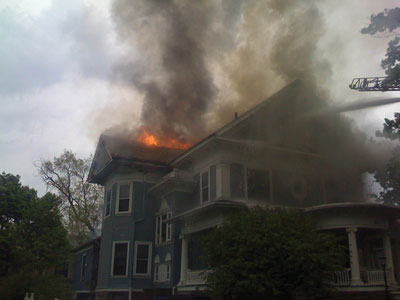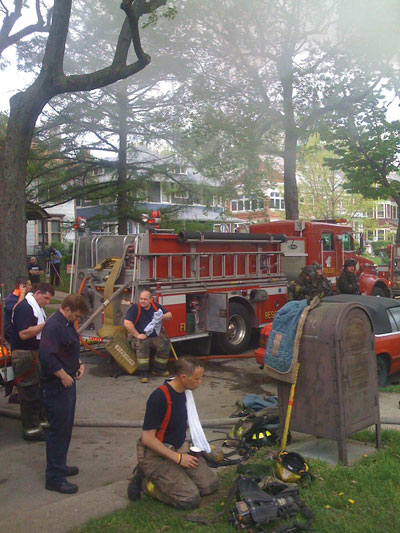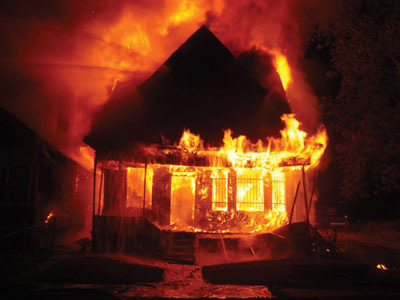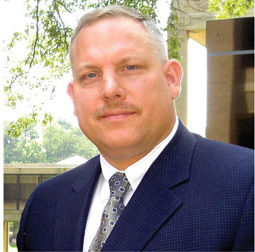
Features
Training
Fire attack
Robert Krause has been a speaker at FDIC Atlantic in Wolfville, N.S.,
for the last couple of years.
January 6, 2012
By Robert Krause
Editor’s note:
Robert Krause has been a speaker at FDIC Atlantic in Wolfville, N.S., for the last couple of years. His classes are always filled to capacity and his enthusiastic teaching style and passion for fire fighting led us to invite him to produce a magazine series on fire attack. Parts 2 and 3 will run in April and July.
 |
|
| Quickly extinguishing a fire in any residential structure greatly improves fire-ground conditions for everyone; search operations occur at a faster rate, property damage is minimized, and the risk to firefighters and occupants is greatly diminished. Photo by Robert Krause |
One of the most exciting aspects of being a firefighter is being first in on the hoseline fighting a fire.
I want to address some basic tenets of fire attack. Fire fighting is a dangerous occupation – just look at the statistics that discuss firefighter injuries and deaths – so it is important that we address fire attack with the safety of the firefighter in mind.
The available staffing at any structure fire will have a definite impact on how many tasks can be completed simultaneously. Incident commanders must assess the risk associated with each task they assign to their limited number of firefighters.
The incident commander and the firefighters must rapidly asses the fire ground and the changing dynamics within the structure as they approach the building that is on fire. While the incident commander is responsible for the overall safety of each firefighter on the fire ground, individual firefighters must accept some responsibility for their safety and welfare. Each firefighter must wear the proper protective clothing, which includes properly fitting structural firefighting coat, pants and boots, and an appropriate helmet, hood and gloves. Additionally, each firefighter entering or working in proximity to a smoke-filled area must use a self-contained breathing apparatus.
This protective ensemble that firefighters wear allows us to penetrate deeper into structures that are on fire, and with this comes increased danger. Therefore, it is imperative that all firefighter look out for themselves and their fellow firefighters as they began a fire attack.
 |
|
| Staffing at any structure fire will impact the number of tasks that can be completed simultaneously. Incident commanders need to assess the risk associated with each task. Photos by Robert Krause |
As we begin discussing fire attack we must address the staffing of the fire apparatus. I have several opportunities to talk with my Canadian firefighting brethren at the annual FDIC conference in Wolfville, N.S. The most common response I have received when asking about staffing on fire apparatus has been three firefighters. So it is with that premise of three firefighters that I continue this discussion.
The first-arriving fire company at any residential structure must complete many tasks. The incident commander must assess how the fire should be attacked. The assessment includes the potential victims within a structure, exposures, and the amount of fire. The initial attack line should be determined by the number of available firefighters and the volume of fire showing. A word of caution here: do not be lulled into thinking that just because there is not a large amount of visible fire that there isn’t more fire deeper within the structure. Limited staffing will certainly have an impact on the size of attack line that can be pulled.
For most residential structure fires, a 45-millimetre (1.5 inch) hand-line flowing between 125 IGPM and 140 IGPM makes an effective fire attack. Achieving that volume of water flow for a fire attack can be easily done with a limited number of firefighters. This high volume of water can be achieved by using a 45-millimetre attack line with a 24-millimetre smoothbore nozzle.
Using smoothbore nozzles in a residential fire attack has many benefits:
- Delivery of 125 IGPM to 140 IGPM by a single firefighter with relative ease.
- Decrease in steam production because of the compact, solid stream (this decrease in steam production prevents steam burns to the firefighter and any potential victims in the area, and it increase visibility to aid search efforts).
- A smoothbore nozzle produces less nozzle reaction (push back) than a fog nozzle flowing similar quantity of water. A fog nozzle flowing 125 IPGM will have about 27 kilograms of nozzle reaction. Therefore, a firefighter using a smoothbore nozzle will have significant fire knock-down capability while at not having to work as hard to advance the nozzle.
- Smoothbore nozzles are less likely than fog nozzles to become obstructed with debris or ice that can be found in attack lines.
A sustained water supply is certainly important in any fire attack. Many North American departments have fire apparatuses that carry at least 415 imperial gallons in the on-board tank. For an aggressive interior fire attack to be successful, a sustainable water supply is important; therefore, incident commanders must think about how they will secure that sustainable water supply, whether by connecting to a local hydrant system or setting up for dump tanks and water shuttles early in their fire-ground strategy.
Let’s discuss the role of the incident commander. The importance of a strong and focused incident commander cannot be understated. Incident commanders who are not calm, focused and clear in their communication to arriving fire companies set the stage for a disorganized and ineffective fire attack, thereby increasing the risk to responding firefighters.
 |
|
| The first-arriving fire company at any residential structure fire must complete many tasks. The incident commander must assess how the fire should be attacked.
|
Equally dangerous are incident commanders who are incapable of making decisions. Responding fire crews expect the incident commander to give them assignments upon their arrival. If you are an ineffective incident commander, please find another line of work, or do us all a favour and stay home. I want to encourage each of you who is an incident commander or aspires to be an incident commander to practise the skills needed to be effective. Look at the buildings in your communities and play the game I call What If? Go out into your communities with your apparatus, pick a building, and ask your crews, “What if fire were coming out of that window? How would we fight this fire?” This is an excellent training exercise.
When I was a company officer I would take my crews to buildings that I thought would pose significant challenges if they caught fire and play the What If? game. We would discuss water supply, hoseline selection, hose length, how we would begin our search for potential victims, and lastly, how we would self-rescue if we got into trouble. This form of planning is invaluable, and I strongly recommend it.
I can tell you that this type of exercise works. Just six months after my crew and I pre-planned a building in this fashion, we had a serious working fire break out at 2 a.m. It was a two-storey, wood-frame structure with a well-developed fire on the second floor. My crew and I were able to quickly stretch the initial attack line and extinguish a large fire very quickly.
Quickly extinguishing a fire in any residential structure greatly improves fire-ground conditions for everyone; search operations occur at a faster rate, property damage is minimized, and the risk to firefighters and occupants is greatly diminished.
Many of you have been told during your training that life safety and rescue is the priority in all fire-ground activities. However, limited staffing can have an impact on the order in which fire attack, search and rescue and ventilation are completed.
Consider the following: Your fire company is dispatched to a residential structure fire. En route, the dispatcher confirms a working fire and there are reports of an elderly woman trapped on the second floor. The apparatus is staffed with three firefighters: the driver, an officer and a firefighter.
Upon arrival you see a two-storey, wood-frame house with moderate smoke conditions showing from side Charlie on the first floor. Bystanders out front report that they just saw the occupant at a window on the second floor, directly above the fire. The next apparatus will arrive in four minutes. Which fire-ground task will you complete first? Attempt a rescue of the trapped woman, or attack the fire?
Attempting a rescue of the trapped woman before making an attack on the fire will place the firefighter and the victim in grave danger. Remember, you have limited staffing, and a fire that is allowed to grow will continue to produce products of combustion, heat and smoke conditions. The growing fire and smoke increases the risk to the firefighter of being cut off from their escape routes. It also hampers visibility in the search for the victim and can lead to both the firefighter and the victim becoming casualties.
When confronted with this type of scenario with limited staffing, I recommend an aggressive attack to extinguish the fire and hydraulic ventilation. This will quickly improve interior conditions, which will aid in the search and rescue of any potential victims. Later arriving crews can be assigned search and -rescue and additional ventilation. Failing to initially extinguish the fire can have disastrous results.
I cannot overemphasize the need for continuous training and practice as it relates to fire suppression. The risks are too high, and fire consumes those who are unprepared.
 |
|
Bob Krause is a battalion chief with the City of Toledo fire department in Ohio and is assigned to Battalion 2. He has 32 years’ experience in emergency services. He holds an International Fire Service Accreditation Congress (IFSAC) certification and several other EMS and fire certifications. Krause has held a variety of positions in the fire service including engine company officer, fire training officer, Fire & EMS Academy program director, fire/EMS communications supervisor and chief of emergency medical services. He is working to complete his doctorate in emergency management. E-mail him at rcktfd@bex.net
Print this page